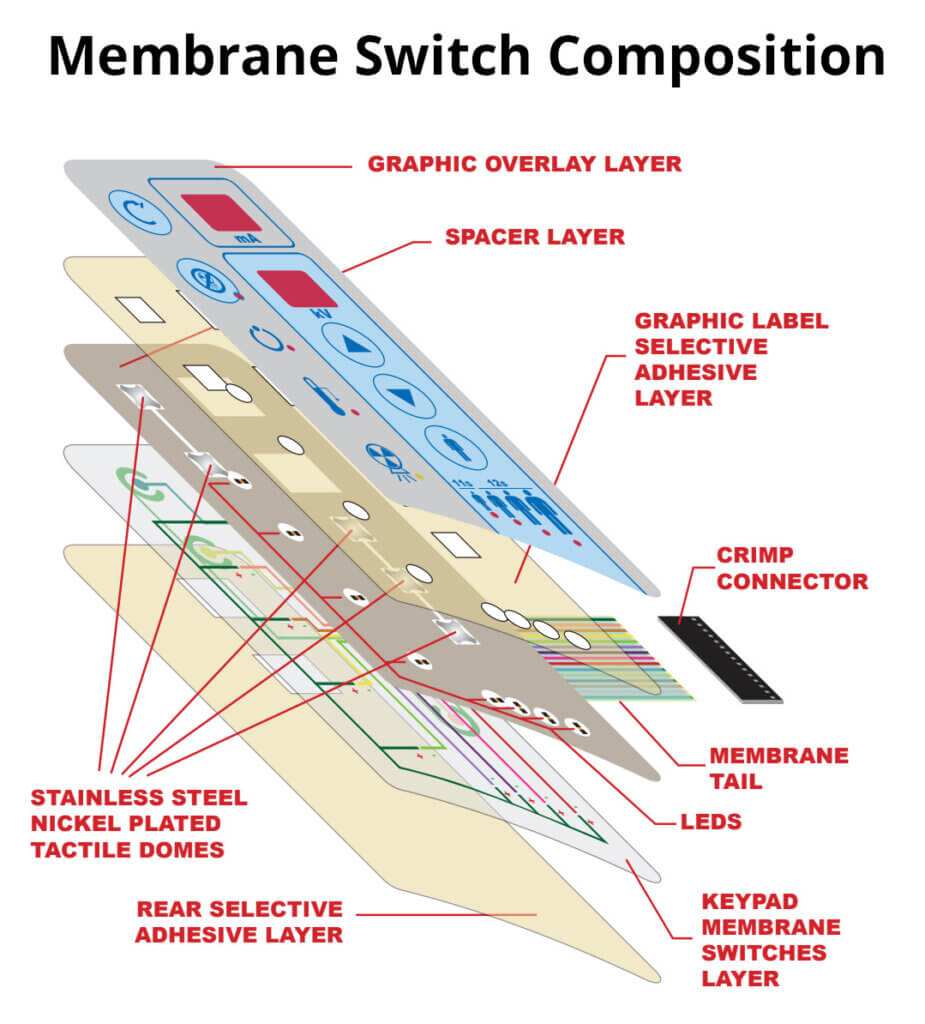How Membrane Switches Are Shaping the Future of Electronic Interfaces
How Membrane Switches Are Shaping the Future of Electronic Interfaces
Blog Article
Understanding Membrane Changes: The Key to Long Lasting and Trustworthy Controls

What Are Membrane Switches?
Membrane buttons are an innovative solution in the realm of individual interface modern technology, incorporating functionality and style effortlessly. These tools function as an interface between individuals and digital systems, incorporating a number of parts right into a portable format. Typically built from adaptable, thin layers of materials, membrane layer buttons are created to react to touch, making it possible for customers to interact with equipment and digital tools properly.
The key components of a membrane layer button consist of a printed circuit layer, graphic overlay, and a spacer layer that avoids unintended activation. The graphic overlay can be customized to mirror brand name identification or individual preferences, enhancing aesthetic appeals while making sure functionality. Membrane buttons are generally used in different applications, including clinical tools, consumer electronics, and commercial tools, owing to their toughness and resistance to environmental elements such as moisture and dirt.
One of the key benefits of membrane switches is their capacity to stand up to wear and tear, making them ideal for high-traffic settings. Furthermore, they are lightweight and call for minimal room, enabling innovative styles in item advancement. Overall, membrane layer switches stand for a useful and efficient selection for contemporary digital interfaces, weding technology with user-centric layout principles.
Just How Membrane Switches Over Work
The procedure of membrane layer switches hinges on a basic yet reliable mechanism that equates individual input right into electronic signals. When a user presses the switch, the leading layer flaws, permitting a conductive element in the circuit layer to make contact with a matching conductive pad on the bottom of the visuals overlay.
The design of membrane switches can vary, however they commonly include domes or tactile elements to offer comments to the individual, boosting the total experience - membrane switch. The products used in membrane switches, such as polyester or polycarbonate, add to their sturdiness and resistance to ecological aspects, consisting of dampness and dirt. The printed circuits are generally encapsulated, which safeguards them from wear and tear over time.
Benefits of Membrane Switches

In addition, membrane layer switches are known for their toughness. Created from durable materials, they are resistant to dust, wetness, and physical wear, which considerably extends their life expectancy compared to traditional mechanical switches. This toughness makes them specifically ideal for high-traffic environments and applications requiring longevity.
An additional substantial advantage is the convenience of cleansing and upkeep. The smooth surface of membrane switches minimizes dust buildup and is often unsusceptible spills, making them perfect for settings that call for constant sanitization.
Additionally, membrane layer switches provide a streamlined account, causing a thinner style that can be integrated into numerous gadgets without adding bulk. This attribute not just improves the aesthetic allure however likewise contributes to an extra ergonomic item design.
Applications of Membrane Layer Buttons
Straightforward and flexible, membrane buttons discover applications across a vast array of markets, including clinical devices, customer electronics, and commercial devices. In the medical area, these switches are integral to gadgets such as diagnostic tools, client monitoring systems, and mixture pumps, where reliability and simplicity of cleansing are crucial. Their capacity to stand up to severe settings and maintain capability makes them optimal for such applications.

In consumer electronic devices, membrane buttons are made use of in products like microwaves, cleaning equipments, and push-button controls - membrane switch. Their streamlined style permits for intuitive interface, boosting the overall customer experience while providing longevity and resistance to use and tear
Commercial equipment likewise gains from membrane layer switches, especially in control panels for equipment and automation systems. These buttons provide protection versus dust and wetness, making certain consistent efficiency in challenging atmospheres. Their customizable attributes enable suppliers to tailor them to particular functional requirements, enhancing effectiveness and capability.
Selecting the Right Membrane Layer Switch
When selecting a membrane layer button, it is necessary to think about different aspects that affect performance and suitability for specific redirected here applications. The try this primary factors to consider consist of ecological conditions, tactile feedback, sturdiness, and design specifications.
First, assess the operating environment; buttons subjected to wetness, chemicals, or extreme temperature levels call for certain materials to ensure long life and functionality. Next off, examine the requirement for tactile responses. Depending upon user communication, some applications might benefit from a tactile feedback to verify activation, while others may favor a non-tactile style for aesthetic factors.
Toughness is one more crucial variable; membrane layer switches must be created to endure constant use, impacts, and abrasion. Make sure the selected button can endure the anticipated lifecycle, particularly in high-usage circumstances.

Verdict
To conclude, membrane layer changes offer as important components in the style of long lasting and dependable control systems across various sectors. Their portable layout, incorporated with durable building and adjustable functions, enhances customer interaction while guaranteeing longevity popular environments. The versatility of membrane layer changes permits customized options that meet specific operational needs, strengthening their significance in modern innovation. As markets continue to evolve, the significance of incorporating effective membrane switch solutions can not be overemphasized.
Membrane changes stand for an essential facet of modern-day user interface style, mixing functionality with strength in different applications.Membrane layer switches are a sophisticated service in the realm of customer interface modern technology, incorporating capability and design flawlessly. Commonly constructed from versatile, thin layers of products, membrane layer buttons are designed to react to touch, allowing users to communicate with equipment and electronic gadgets efficiently.
The design of membrane layer switches can vary, yet they frequently include domes or tactile components to give responses to the individual, boosting the general experience.In conclusion, membrane layer switches over serve as crucial elements in the style of reliable and sturdy control look here systems throughout various sectors.
Report this page